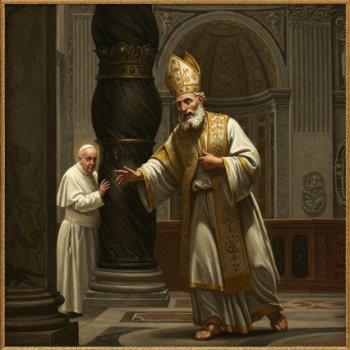VII. Postmodern Theology and Jean-Luc Marion: An(other) interlude, on Benedictine ‘Caritas’
VI. Postmodern Theology and Jean-Luc Marion: Recap
V. Postmodern Theology and Jean-Luc Marion: An interlude on the ‘theological turn,’ continued
IV. Postmodern Theology and Jean-Luc Marion: An interlude on the ‘theological turn’
III. Postmodern Theology and Jean-Luc Marion: From ‘ego cogito’ to ‘ego amans’
II. Postmodern Theology and Jean-Luc Marion: Being and Giveness
I. Postmodern Theology and Jean-Luc Marion (a brief opening move)
I fear that this series has become a joke. I keep saying what I am going to do (in good faith) and then neglecting my self-imposed task until I return to it via a distraction. Three times now, I have returned to it from some unrelated readings. In this instance, lacking time to read the nearly 800 page A Secular Age (2007) by Charles Taylor, I opted for Peter Gordon’s erudite review from the Journal of the History of Ideas in 2008. In it, I found a striking parallel to Marion’s “ego amans” that I described in Part III. You can download it here for free (courtesy of Project Muse). A longer version of these observations will constitute my remarks this weekend at a panel entitled, “From Ego Cogito to Ego Amans: A Conversation About Love and Tragedy, Understanding, Poetry and Humor in Curriculum” at the 30th Annual Bergamo Conference on Curriculum Theory and Classroom Practice
In The Erotic Phenomenon, Jean-Luc Marion remarks that, in the original Latin of Descartes’ Meditations, the ego is described excluding love. The first translator of Descartes from Latin into French, Duc de Luynes, added, “which loves, which hates” to the opening of Descartes’ Third Meditation. Marion favors this revision—albeit a revision unintended by Descartes—and exhorts us to take up Duc de Luynes’ addition to the ego and see ourselves “as the cogitans that thinks insofar as it first loves, in short as the lover (ego amans)… substituting for the ego cogito, which does not love.”
This challenges the ontological implication of Descartes’ cogito and affirms Augustine’s claim: Nemo est qui non amet; She is not one who would not love; She who would not love is no-thing; Without love, I am nothing. In other words, I do not think and therefore exist, as Descartes would have it—I love and therefore exist and think and love again (and again and again…).
Marion’s exhortation contra-Descartes also takes the form of a question and answer. He asks, “Why is love thrown to the wind, why is it refused an erotic rationality…” He replies to his own question, saying:
The answer is not hidden far away: because love is defined as a passion, and therefore as a derivative modality, indeed as an option to the “subject”… And, in fact, we think of ourselves most of the time as just such an ego, a being who cogitates orderable and measurable objects, so that we no longer look upon our erotic events except as incalculable and disordered accidents happily marginalized, indeed optional…
Earlier in the book, Marion makes this striking statement:
The result of these failed efforts is that ordinary people, or, put another way, all those who love without knowing what love wants to say, or what it wants of them, or above all how to survive it—that is to say, you and I first and foremost—believe themselves condemned to feed on scraps: desperate sentimentalism of popular prose, the frustrated pornography of the idol industry, or the shapeless ideology of that boastful asphyxiation known as ‘self-actualization.’ Thus philosophy keeps quiet, and in this silence love fades away.
For Marion, this silence of philosophy is neither a disciplinary silence in academia nor a problem in the history of philosophy. It is, first and foremost, the silence of philo–sophia: love of wisdom. It is the alienated silence of love to itself, the restraining of eros from its passionfruit, love. This strange philo-sophical forgetting of love is even more prescient and fundamental to Marion than the neglect of being famously noted by Heidegger in Being and Time; and in this abandonment of love we find a critical question of the constitution of the subject in and by the modern world.
In Charles Taylor’s book A Secular Age (according to Gordon’s review), published the same year (2007) as the English publication of Marion’s Erotic Phenomenon, we find a striking similarity between the two. Like with Foucault’s genealogies—whose source is not power, pure and simple, but the production of the subject by biopower—so too with Taylor, in that the Secular Age is described in terms of how its “disciplinary society” built a “new model of the human being.” Gordon writes:
With the rise of the disciplinary society Taylor also sees a change in the very conception of human being. The older conception of the self as embedded in a holistic but differentiated natural-social-theological order slowly gave way to a “disembedded” selfhood understood to be ontologically prior to and independent of its surroundings. The realist conception of the world as the bearer of intrinsic meanings to which we must conform was supplanted by the notion that the only orders we must acknowledge are those we construct for ourselves. The social imaginary no longer envisioned as an interdependent system working in concert but a dispersal of atomistic individuals only to themselves and only contingently responsive to those around them.
This new human being that Taylor sees as the hallmark of the disciplinary society built by the Secular Age is strikingly similar to the Cartesian ego cogito critiqued by Marion. Taylor calls it “the buffered self.” This “buffered self” is the kind of ego that, according to Taylor, replaced the “porous self” during the modern, secular Enlightenment ushered in by Descartes, Locke, and Kant. Gordon describes Taylor’s “buffered self” as one that is, “assertive, rationalistic and stakes a claim to autarky that shuts down its experience of intimacy even in relation to its own bodily passions.”
In striking similarity to the dialectic of Descartes’ ego cogito vs. Duc de Luynes’ ego amans we find in Marion, Taylor’s description of the buffered and porous self brings out the tragic elements of this Tragic Lover. (Elements that, for Taylor, come cloaked in religious mysticism.) He writes:
Living in a disenchanted world, the buffered self is no longer open, vulnerable to a world of spirits and forces which cross the boundary of the mind, indeed, negate the very idea of there being a secure boundary. The fears, anxieties, even terrors that belong to the porous self are behind it. This sense of self-possession, of a secure inner mental realm, is all stronger, if in addition to disenchanting the world, we have also taken the anthropocentric turn and no longer even draw upon the power of God.
The description of the dispossessed and insecure porous self as something fearful, anxious, and even terrorized adds a layer of tragic meaning (and mystery!) to the ego amans of Marion. This marriage of a an amorous ego and a porous self is ultimately a matter of knowing in that deep ontological sense of existential intimacy (connaissance or conocer, as opposed to savoir or saber) that to offer true love is to be a Tragic Lover: the lover who rejects the nihilism of capitalist individualism and throws herself into the flux of relations in the life-world, come what may.
















